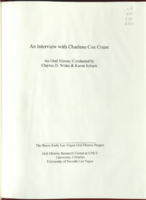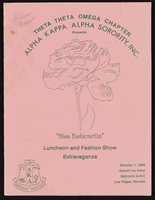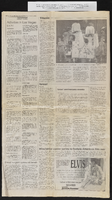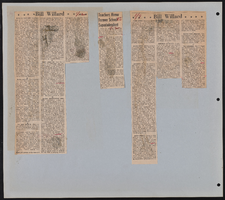Search the Special Collections and Archives Portal
Search Results

Transcript of interview with Valerie Wiener by Barbara Tabach, January 20, 2015
Date
Archival Collection
Description
Valerie Wiener is an accomplished state senator, business owner, president and founding member of the Public Service Institute of Nevada and the Valerie Wiener Foundation. She was born October 30, 1948 in Las Vegas, Nevada. Her service as senator for 16 years and her role as a public servant led her to become the first woman assistant majority leader of the state senate in Nevada. She graduated with a bachelor degree of Journalism at the University of Missouri/Columbia within the School of Journalism earning a Masters of Arts in Broadcast Journalism and a Master of Arts in Literature at the University of Illinois in Springfield while attending law school at McGeorge School of Law in Sacramento in the 1970s. Her generosity is also seen through scholarships and activities at the Louis Wiener Jr. Elementary School. In addition, Valerie is a professional speaker, consultant, and internationally published author. She is the recipients of many awards, such as: ?Women of Achievement Award? in Media; ?Healthy Schools Heroes?; ?Public Affairs Champion Award?; ?Legislator of the Year?, and the Nevada Secretary of State?s recipient of the ?Jean Ford Participatory Democracy Award.? She stays active through her commitment to the Nevada Senior Olympics for both Fitness and Weightlifting earning 17 gold medals from 1998 to 2007. In this interview, Wiener discusses her childhood and being raised in Las Vegas in the 1950s as well as the academic path that led her career into politics. She shares memorable insight into the life of her father, Louis Isaac Wiener, Jr., an accomplished attorney and business man who represented the infamous Benjamin ?Bugsy? Siegel during the construction and opening of the Flamingo Hotel and Casino in 1946. Throughout Wiener?s interview, she highlights the traditions of the small, but growing Las Vegas Jewish population in the 1960s. Among the people she recalls most vividly is her grandmother Kitty Wiener. Wiener also discusses her community service work and her life mantra of giving.
Text
Lawrence Chiu Hill oral history interview
Identifier
Abstract
Oral history interview with Lawrence Chiu Hill oral history interview conducted by Cecilia Winchell, Nessa Concepcion, and Stefani Evans on November 8, 2021 for Reflections: The Las Vegas Asian American and Pacific Islander Oral History Project. Lawrence "Larry" Chiu Hill shares his experiences growing up in Taiwan and immigrating with his family to South America, then moving to Corpus Christi, Texas, and finally Las Vegas, Nevada. He discusses his education at University of Nevada, Las Vegas as a Political Science graduate and his career path moving from casino gaming into the practice of law. Lawrence manages his own firm, Lawrence C. Hill and Associates, and talks about his work, his family, and the community he has created in over two decades of living in Las Vegas.
Archival Collection
Kent Carmichael oral history interview
Identifier
Abstract
Oral history interview with Kent Carmichael conducted by Stefani Evans on November 25 and December 2, 2019 for the Boyer Early Las Vegas Oral History Project.
In the first session of this oral history, Carmichael discusses his early career in lighting design and maintenance from his start at Interstate Neon to his work in the 1950s and 60s in Las Vegas. He discusses some of the iconic signs he built including the Casino Center, Carnival Room, Thunderbird, The Frontier, Bonanza, and the Stardust. He also details the technology and inner workings of these innovative signs including the transition from mechanical to electrically controlled signage. Carmichael continues to discuss Native American laborers and various individuals that he interacted with throughout his early career including Max and Mo Oggenblick, Doby Doc, Benny Binion, Arby Alper, Steve Wynn, Peter Arp, and Wayne and Jerry Newton. Carmichael ends the first interview by recalling a high wind event that damaged the Frontier sign and his efforts to bring the sign under control and repair it as well as his vision and behind the Stardust sign.
The second oral history interview contains Carmichael’s discussion of his career from 1968 onward. He immediately picks up discussion of the Stardust sign and his transition to desk work. Carmichael details the challenge and limitations of designing the International sign (the Westgate as of 2021). He describes the development of his first messenger sign for the International and the time consuming task of using tape to program the sign. He fondly remembers working on the Holiday Inn Riverboat signs, and International transition to Las Vegas Hilton and the Hilton’s transition from blue to red letters. Carmichael shares the story of being caught between organized crime and a young Steve Wynn. He recounts his last project for Ad Art, developing and construction the sign for the Louisiana Superdome in New Orleans, Louisiana. He details working through legislative and construction issues as well as the fallout from the Nat Kiefer Commission.
After leaving Ad Art Carmichael began working with Heath and Co. and began collaborating with Raul Rodriguez. Carmichael and Rodriguez went on to design some of the most enduring and visually unique signs in Las Vegas including, the Flamingo, Four Queens, Golden Nugget, Dunes Hotel, and the Desert Inn. They also worked in Reno on Circus Circus and El Dorado. Carmichael also details his interior work including the main pylon and interior signs for MGM Grand; 1974 renovation Golden Nugget, suspended stained glass ceiling at Tropicana, and the MGM Lion display. Lastly Carmichael outlined his work with Young Electric Sign 1983-85 and the Dewey Sign Company including the Las Vegas Convention Center sign. He ends by sharing his views on the role and importance of lighting in Las Vegas.
Archival Collection

Transcript of interview with Charlene Cox Cruze by Claytee D. White and Karen Schank, August 9, 2010
Date
Archival Collection
Description
Text

Transcript of interview with Santo Savino by Lisa Gioia-Acres, September 23, 2008
Date
Archival Collection
Description
Santo was born in the Bronx, New York in 1937. Santo’s family includes his father who was a butcher, and his mother who mostly stayed at home to raise the children, as well as a brother who currently lives with Santo. Santo recalls that it was great growing up in the Bronx, and he spent most of his life there until he joined the Air Force when he was 17. Santo’s immediate family was not musically oriented, but he learned to play the drums from a cousin. Music came easy for Santo, and he started getting paid for playing when he was 12. At 17, Santo joined the Air Force with a group of friends. He auditioned for and was accepted into the Air Force band where he played drums for four years. Santo was married with a child and another child on the way when he ended his military career and moved to California. After jobs working as a security guard and on an assembly line, Santo knew he just wanted to play and came to Las Vegas in 1960 to play with a band. It took several years before Santo was able to get on with a permanent band. Once Santo broke into the scene in Las Vegas, he played for six years at the Flamingo. Following that he was on the road for a couple of years with Paul Anka. Upon returning to Las Vegas, Santo worked for 14 years at the Sahara. Santo talks about when “the boys” had the hotels before the corporations came in and how everything changed. Currently, Santo does a lot of work with trumpet player Carl Saunders, frequently traveling to Los Angeles to do recordings together.
Text

Alpha Kappa Alpha Sorority, Theta Theta Omega Chapter "Miss Fashionetta souvenier journal
Date
Archival Collection
Description
From the Alpha Kappa Alpha Sorority, Incorporated, Theta Theta Omega Chapter Records (MS-01014) -- Chapter records file.
Text
The Vista Group. Vista Realty Inc.
Vista Group is a real estate development company for office, retail, industrial and residential projects. It was founded by Michael Saltman, the managing general partner and president. Saltman also founded and served as managing general partner of the Flamingo Decatur Partnership and managing partner of Ford Aerospace and Communications Corporation Development, Las Vegas Technology Center.Saltman earned his BA from Michigan State University and his law degree from Wayne State University Law School.
Corporate Body


